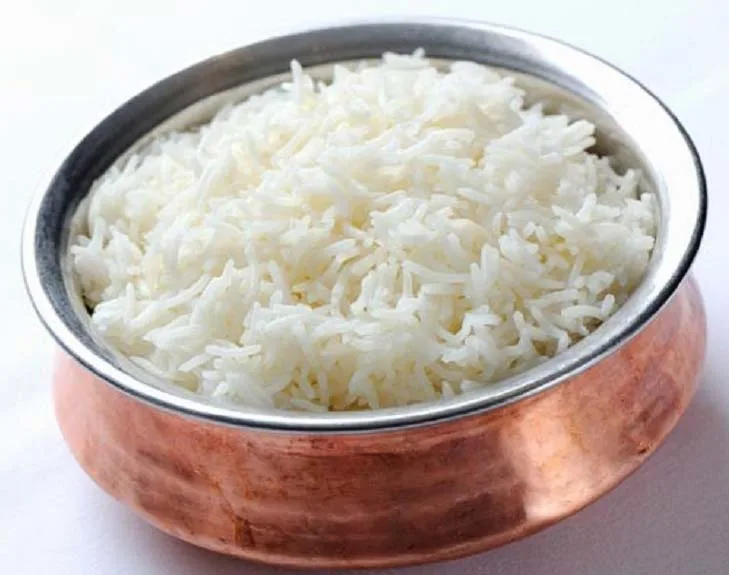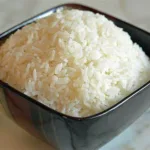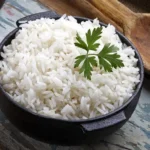Table of Contents
About Steamed Rice
Steamed Rice is a staple food enjoyed in many cultures around the world. It is a simple and versatile dish made by cooking rice with water, resulting in fluffy and tender grains. Steaming rice allows it to retain its natural flavors and textures while preserving its nutritional value. Whether served as a side dish or as a base for various cuisines, steamed rice provides a comforting and satisfying foundation for a wide variety of meals. Its neutral taste makes it a versatile accompaniment to a range of flavors and dishes, making it a beloved and timeless favorite.
Ingredients for making Steamed Rice
- 1 mug long- grain white rice
- 2 mugs water
- swab( voluntary)
Instructions for making Steamed Rice
- Wash the rice in a fine- mesh strainer until the water runs clear.
- In a saucepan with a tight- befitting lid, bring the water to a pustule.
- Add the rice and swab( if using), and stir to combine.
- Reduce the heat to low, cover the visage with the lid, and poach for about 18- 20 twinkles, or until the water has been absorbed and the rice is tender.
- Remove the visage from the heat and let it sit, covered, for 5 twinkles.
- Fluff the rice with a chopstick before serving.
Steamed rice can be served as a main course with Rasam, and Sambar enjoyed on its.
Note: The rate of water to rice may vary depending on the type of rice you are using. Check the package instructions for the recommended water- to- rice rate. Also, you can add sauces or spices to the rice while it’s cooking to add further flavor.
Nutritional Value of Steamed rice
Steamed rice is a simple dish made by boiling rice in water until it’s tender and ethereal. The nutritional value of fumed rice can vary depending on the type of rice used and the portion size, but then’s the approximate nutritive value of one mug of cooked long- grain white rice
- Calories 205
- Carbohydrates 45g
- Protein 4g
- Fat0.4 g
- Fiber0.6 g
- Sodium 1 mg
- Iron 1 mg
- Calcium 10 mg
- Potassium 55 mg
- Magnesium 19 mg
Steamed rice is a good source of carbohydrates and provides some protein, iron, and magnesium. still, it’s low in fiber, fat, and other essential nutrients, so it’s important to brace it with other nutritional foods to make a balanced mess. Steamed rice is a protean dish that can be used as a base for many different recipes, and it’s a common staple food in many cultures around the world.


Health Benefits
Eating steamed rice can offer several health benefits due to its nutritious composition and cooking method. Here are some potential health benefits of consuming steamed rice:
- Good Source of Energy: Steamed rice is a rich source of carbohydrates, which are the body’s primary source of energy. It provides fuel for the brain and muscles, supporting daily activities and physical performance.
- Low in Fat and Cholesterol: Steamed rice is naturally low in fat and contains no cholesterol. It can be a healthier alternative to high-fat foods, contributing to a balanced diet and helping to maintain a healthy weight.
- Gluten-Free and Easy to Digest: Steamed rice is naturally gluten-free, making it suitable for individuals with gluten sensitivities or celiac disease. It is also easily digestible, which can be beneficial for those with digestive issues or sensitive stomachs.
- Source of B Vitamins: Rice, especially brown rice, is a good source of B vitamins such as thiamin (B1), niacin (B3), and pyridoxine (B6). These vitamins are essential for energy metabolism, proper nervous system function, and overall cellular health.
- Provides Essential Minerals: Steamed rice contains minerals like magnesium, phosphorus, and selenium. These minerals contribute to bone health, support cellular function, and act as antioxidants in the body.
It’s important to note that the nutritional value of steamed rice can vary depending on the type of rice used, such as white or brown rice. Brown rice generally offers more dietary fiber and a slightly higher nutrient profile compared to white rice. Opting for whole grain rice varieties can further enhance the nutritional benefits of steamed rice.
Steam Rice for Weight Loss
Steamed rice can potentially aid in weight loss when consumed as part of a balanced and calorie-controlled diet. Here’s how it may contribute to weight loss efforts:
- Low in Fat: Steamed rice is naturally low in fat, which makes it a suitable choice for those aiming to reduce their overall fat intake. By opting for steamed rice over higher-fat alternatives, individuals can create a calorie deficit and support weight loss goals.
- Satiating and Filling: Steamed rice is a source of complex carbohydrates that can provide sustained energy and promote feelings of fullness. The fiber content in whole grain rice varieties, such as brown rice, can further enhance the satiating effect. Feeling satisfied for longer periods may reduce the likelihood of overeating or consuming calorie-dense foods.
- Portion Control: Steamed rice can be easily portioned and measured, allowing for better control over calorie intake. By being mindful of portion sizes and incorporating appropriate portions of steamed rice alongside protein, vegetables, and other nutrient-rich foods, individuals can manage their calorie intake effectively.
- Nutrient Density: While steamed rice is not particularly high in nutrients compared to other foods, it can be part of a well-rounded and nutritious meal. By pairing steamed rice with vegetables, lean proteins, and healthy fats, individuals can create a balanced meal that provides essential nutrients while still being mindful of calorie intake.
It’s important to note that weight loss is influenced by various factors, including overall dietary patterns, physical activity levels, and individual metabolism. While steamed rice can be a part of a weight loss strategy, it is essential to consider the overall calorie balance and incorporate a variety of nutrient-dense foods in a well-rounded diet.
Tips and Tricks
Here are some tips and tricks for steaming rice:
- Choose the right rice: Use long-grain rice varieties such as basmati or jasmine for best results when steaming. These rice types tend to have a fluffy texture and distinct aroma.
- Rinse the rice: Rinse the rice under cold water to remove excess starch. This helps prevent the rice from becoming too sticky. Rinse until the water runs clear.
- Soak the rice (optional): Soaking the rice for 15-30 minutes before cooking can help improve the texture and reduce cooking time. However, this step is optional and can be skipped if you’re short on time.
- Use the proper rice-to-water ratio: The ratio of rice to water can vary depending on the type of rice and personal preference. As a general guideline, use 1.5 to 2 cups of water for every cup of rice. Adjust the ratio slightly based on your desired rice texture (softer or firmer).
- Add flavor (optional): For added flavor, you can include ingredients like a pinch of salt, a drizzle of oil, or a few aromatics such as bay leaves, cloves, or cardamom pods to the rice and water mixture.
- Choose a suitable pot or steamer: Ensure you have a pot or steamer with a tight-fitting lid. This helps trap the steam and cook the rice evenly.
- Bring to a boil, then simmer: Place the rinsed and drained rice in the pot with the measured water. Bring it to a boil over medium-high heat, then reduce the heat to low and cover with the lid. Allow the rice to simmer gently until all the water is absorbed and the rice is tender. Avoid lifting the lid during cooking to prevent steam from escaping.
- Fluff the rice: Once the rice is cooked, remove it from the heat and let it sit, covered, for a few minutes. Then, use a fork to gently fluff the rice to separate the grains.
- Rest before serving: Allow the rice to rest for a few minutes after fluffing. This helps the grains settle and become even more tender.
Remember, steaming rice is a versatile cooking method, and the exact process may vary based on personal preference and the specific type of rice you’re using. Adjustments to cooking time and water ratio might be necessary depending on your desired texture and the quality of the rice. Practice and experimentation will help you find the perfect steamed rice method that suits your taste.
Serving Suggestions
Serving Suggestions for Steamed Rice:
- Pair with Indian Curries: Steamed rice is a versatile accompaniment to a wide range of Indian curries such as dal, vegetable curries, chicken curry, or paneer dishes. The fluffy texture of the rice complements the rich and flavorful curries.
- Top with Ghee: For an authentic touch, drizzle a little bit of ghee (clarified butter) over the steamed rice. It adds a delicious nutty flavor and enhances the overall taste.
- Serve with Pickles: Steamed rice pairs wonderfully with various Indian pickles such as mango pickle, lime pickle, or mixed vegetable pickle. The combination adds a burst of tangy and spicy flavors.
- Enjoy with Raita: Serve steamed rice with refreshing raita made from yogurt, cucumber, tomatoes, and spices. The cool and creamy raita balances the heat of spicy dishes.
- Create Rice Bowls: Turn steamed rice into a complete meal by serving it in rice bowls topped with your favorite protein, vegetables, and sauces.
- Mix with Lentils: For a wholesome and nutritious meal, mix steamed rice with cooked lentils (dal) or other legumes. This combination provides a good balance of carbohydrates and protein.
- Make Fried Rice: Use leftover steamed rice to make flavorful fried rice with vegetables, tofu, or your choice of protein. Add soy sauce and seasonings for a tasty twist.
- Use as a Base for Buddha Bowls: Create nutritious Buddha bowls by layering steamed rice with a variety of cooked and raw vegetables, protein, and dressings.
Remember to fluff the steamed rice with a fork before serving to avoid clumping. It provides a blank canvas for various flavors and complements the richness of Indian dishes. Enjoy steamed rice as a comforting and essential staple in Indian cuisine.
FAQs
Is it better to Steam or Boil Rice?


Both steaming and boiling rice have their benefits, and the choice depends on personal preference and desired outcome. Steaming rice helps retain more nutrients and preserves the texture of the grains, resulting in fluffy and separate rice. Boiling rice can be quicker and simpler, especially for certain rice dishes or recipes that require a stickier texture. Ultimately, it’s a matter of preference and the specific requirements of the dish being prepared.
How to steam rice without a Steamer?


To steam rice without a steamer, you can use a pot and a tight-fitting lid:
1) Rinse the desired amount of rice under cold water until the water runs clear.
2) Place the rice in a pot and add the appropriate amount of water. The ratio is typically 1:2, one part rice to two parts waters.
3) Bring the water to a boil, then reduce the heat to low, cover the pot with the lid, and simmer for about 15-20 minutes until the rice is cooked and the water is absorbed. Avoid opening the lid during this time to maintain steam.
This method allows the rice to steam within the covered pot, resulting in fluffy and perfectly cooked rice. Remember to adjust the cooking time based on the specific type of rice being used and follow any package instructions for best results.

